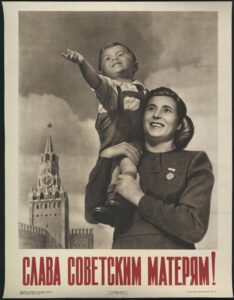
The status of single mothers in post-war Soviet Russia was truly exceptional. In 1944, the Soviet State introduced groundbreaking legislation that marked the first modern historical instance of defining a ‘single mother’ in legal terms. With the anticipation of an impending victory in World War II, the government began strategizing ways to address the population decline. However, the country’s societal fabric remained rooted in patriarchal values, with a significant portion of the rural population adhering to conservative notions of the traditional family structure. This situation was uniquely complex in several other aspects.
Soviet single mothers often found themselves navigating a complex web, caught between the official permission to bear a child outside of marriage and deeply ingrained cultural biases. In response to this intricate dilemma, they undertook a process of reevaluating cultural norms and behavioral patterns, a phenomenon that I refer to as the ‘Cultural Code of Single Motherhood in Post-war Soviet Russia’. I propose that the strength of this cultural code lies in its adaptability, which evolves alongside shifts in Soviet society. As the social landscape becomes more lenient, the cultural code adjusts accordingly. The surge in divorce rates during the 1970s and the growing acceptance of single motherhood as a transitional phase in women’s lives contributed to a more inclusive perception of single mothers. Nonetheless, this cultural code also imposed certain limitations, constraining the visibility of single mothers and their agency. A ‘model’ single mother was expected to be entirely devoted to child-rearing, deflecting male attention, and contributing through labour. Pursuing physical attractiveness or remarriage was discouraged. The favourable social portrayal of single mothers encompassed a range of attributes, including unwavering love for their children, active engagement in domestic responsibilities, compassion, diligence, and societal worth. As long as these qualities were evident, other deviations were tolerated, thereby ensuring the cultural code’s endurance, despite apparent contradictions.
To trace the shifts in the cultural code I analysed the dynamics of single mother characters in short stories:
V. Panova’s ‘Volodya’ (1959), ‘Boy and Girl’ (1960), ‘Synopsis of the novel’ (1965);
I. Grekova’s ‘Summer in the City’ (1962)
M. Ganina’s ‘Featherhead’ (1965)
G. Shcherbakova’s ‘Who is one of you the general, girls?’ (1966–1974)
M. Khalfina’s ‘Fatherless’ (1975)
N. Baranskaya’s ‘Witchcraft’ (1976), ‘Kiss’ (1981)
I. Velembovskaya’s ‘View from the balcony’ (1981)
V. Tokareva’s ‘Nothing special’ (1983)
V. Sidorenko’s ‘Marka’ (1984)
To read about the cultural code: Single Motherhood in Postwar Soviet Russia Cultural Code and its Literary Implication
I like this website it’s a master piece! Glad I noticed this
ohttps://69v.topn google.Expand blog